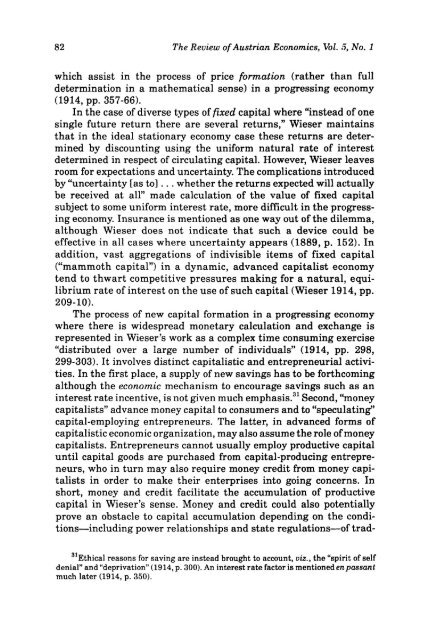Review of Austrian Economics - The Ludwig von Mises Institute
Review of Austrian Economics - The Ludwig von Mises Institute
Review of Austrian Economics - The Ludwig von Mises Institute
Create successful ePaper yourself
Turn your PDF publications into a flip-book with our unique Google optimized e-Paper software.
82 <strong>The</strong> <strong>Review</strong> <strong>of</strong> <strong>Austrian</strong> <strong>Economics</strong>, Vol. 5, No. 1<br />
which assist in the process <strong>of</strong> price formation (rather than full<br />
determination in a mathematical sense) in a progressing economy<br />
(1914, pp. 357-66).<br />
In the case <strong>of</strong> diverse types <strong>of</strong> fixed capital where "instead <strong>of</strong> one<br />
single future return there are several returns," Wieser maintains<br />
that in the ideal stationary economy case these returns are determined<br />
by discounting using the uniform natural rate <strong>of</strong> interest<br />
determined in respect <strong>of</strong> circulating capital. However, Wieser leaves<br />
room for expectations and uncertainty. <strong>The</strong> complications introduced<br />
by "uncertainty [as to]... whether the returns expected will actually<br />
be received at all" made calculation <strong>of</strong> the value <strong>of</strong> fixed capital<br />
subject to some uniform interest rate, more difficult in the progressing<br />
economy. Insurance is mentioned as one way out <strong>of</strong> the dilemma,<br />
although Wieser does not indicate that such a device could be<br />
effective in all cases where uncertainty appears (1889, p. 152). In<br />
addition, vast aggregations <strong>of</strong> indivisible items <strong>of</strong> fixed capital<br />
("mammoth capital") in a dynamic, advanced capitalist economy<br />
tend to thwart competitive pressures making for a natural, equilibrium<br />
rate <strong>of</strong> interest on the use <strong>of</strong> such capital (Wieser 1914, pp.<br />
209-10).<br />
<strong>The</strong> process <strong>of</strong> new capital formation in a progressing economy<br />
where there is widespread monetary calculation and exchange is<br />
represented in Wieser's work as a complex time consuming exercise<br />
"distributed over a large number <strong>of</strong> individuals" (1914, pp. 298,<br />
299-303). It involves distinct capitalistic and entrepreneurial activities.<br />
In the first place, a supply <strong>of</strong> new savings has to be forthcoming<br />
although the economic mechanism to encourage savings such as an<br />
interest rate incentive, is not given much emphasis. 31 Second, "money<br />
capitalists" advance money capital to consumers and to "speculating"<br />
capital-employing entrepreneurs. <strong>The</strong> latter, in advanced forms <strong>of</strong><br />
capitalistic economic organization, may also assume the role <strong>of</strong> money<br />
capitalists. Entrepreneurs cannot usually employ productive capital<br />
until capital goods are purchased from capital-producing entrepreneurs,<br />
who in turn may also require money credit from money capitalists<br />
in order to make their enterprises into going concerns. In<br />
short, money and credit facilitate the accumulation <strong>of</strong> productive<br />
capital in Wieser's sense. Money and credit could also potentially<br />
prove an obstacle to capital accumulation depending on the conditions—including<br />
power relationships and state regulations—<strong>of</strong> trad-<br />
31 Ethical reasons for saving are instead brought to account, viz., the "spirit <strong>of</strong> self<br />
denial" and "deprivation" (1914, p. 300). An interest rate factor is mentioned en passant<br />
much later (1914, p. 350).

















